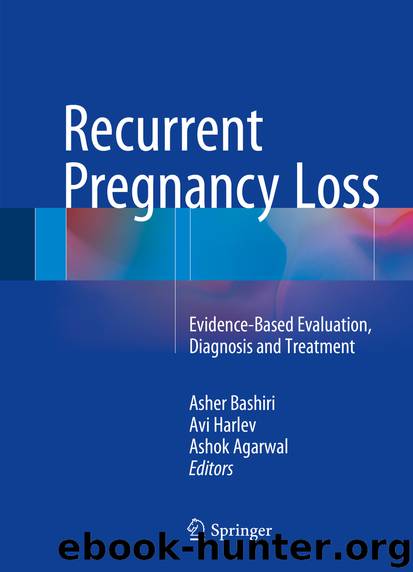Recurrent Pregnancy Loss by Asher Bashiri Avi Harlev & Ashok Agarwal

Author:Asher Bashiri, Avi Harlev & Ashok Agarwal
Language: eng
Format: epub
Publisher: Springer International Publishing, Cham
Treatment of Uterine Malformations
Raga et al. [49], in their review, summarized the current management of the different types of uterine malformations. For septate and arcuate uterus, hysteroscopic metroplasty is the treatment of choice. The other anomalies, which are less frequently encountered, may require more complicated abdominal or combined procedures or may even not have a surgical solution. The strategy of management must be based either on the obstetric history of the patient or on the prognosis of the malformation itself. Most clinicians do not recommend the Strassman procedure, which was associated with a high percentage of complications. The main concept in the treatment of uterine malformations is close monitoring and follow-up in high-risk pregnancy clinic, bed rest, and progesterone treatment for the prevention of preterm delivery.
Cerclage is indicated in cases with cervical os incompetence diagnosed by medical history or shortened cervical length by ultrasound. Cervical os incompetence is difficult to diagnose and is not a common cause of RPL even in patients with profound structural uterine abnormality. However, cerclage has recently been offered as a treatment for women with RPL and a uterine anomaly other than a septate uterus. Seidman et al. [51] compared the survival rate of fetuses in 86 women with congenital uterine anomalies and 106 women with normal anatomy. The incidence of cervical os incompetence proven by HSG was 23 % in the two groups. Sixty-seven out of 86 and 29 out of 106 were managed with cervical cerclage. The obstetric outcome was stratified by cervical incompetence and obstetric history. The viable live birth rate was significantly higher in the malformed group with cerclage (88 %) compared with the malformed group without cerclage (47 %). No statistically significant differences in live birth rate were found in the normal uterus with cerclage even when only those women with a history of RPL were considered. The indications for cerclage are still controversial. The CIPRACT study found that therapeutic cerclage with bed rest reduced neonatal morbidity and preterm delivery rates in women with risk factors (including DES exposure and uterine anomaly) and/or cervical os incompetence and cervical length of <27 mm before 27 weeks gestational age [52].
Yassaee and Mostafaee [53] studied 40 patients with uterine anomalies, 26 were treated with cerclage and 14 without cerclage. In patients with bicornuate uterus and cervical cerclage, term delivery rate was 76.2 % compared to 27.35 % in the group without cerclage (p < 0.05). Among patients with uterus arcuatus, preterm delivery rate was not statistically different between those with or without cerclage.
Cervical os incompetence is still considered an infrequent cause of pregnancy loss in patients with major structural anomalies of the uterus. We recommend to consider prophylactic cerclage for those patients with uterine anomalies such as bicornuate uterus and unicornis uterus with a history of RPL or preterm delivery.
Download
This site does not store any files on its server. We only index and link to content provided by other sites. Please contact the content providers to delete copyright contents if any and email us, we'll remove relevant links or contents immediately.
| Administration & Medicine Economics | Allied Health Professions |
| Basic Sciences | Dentistry |
| History | Medical Informatics |
| Medicine | Nursing |
| Pharmacology | Psychology |
| Research | Veterinary Medicine |
Tuesdays with Morrie by Mitch Albom(4690)
Yoga Anatomy by Kaminoff Leslie(4306)
Science and Development of Muscle Hypertrophy by Brad Schoenfeld(4089)
Bodyweight Strength Training: 12 Weeks to Build Muscle and Burn Fat by Jay Cardiello(3913)
Introduction to Kinesiology by Shirl J. Hoffman(3725)
How Music Works by David Byrne(3187)
Sapiens and Homo Deus by Yuval Noah Harari(2987)
The Plant Paradox by Dr. Steven R. Gundry M.D(2547)
Churchill by Paul Johnson(2506)
Insomniac City by Bill Hayes(2497)
Coroner's Journal by Louis Cataldie(2432)
Hashimoto's Protocol by Izabella Wentz PharmD(2331)
The Chimp Paradox by Peters Dr Steve(2297)
The Universe Inside You by Brian Clegg(2097)
Don't Look Behind You by Lois Duncan(2080)
The Immune System Recovery Plan by Susan Blum(2027)
The Hot Zone by Richard Preston(1983)
Endure by Alex Hutchinson(1964)
Woman: An Intimate Geography by Natalie Angier(1882)
